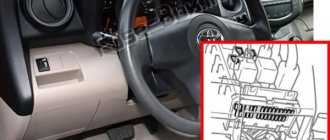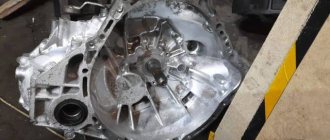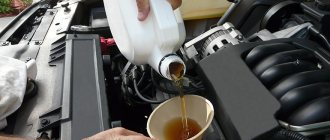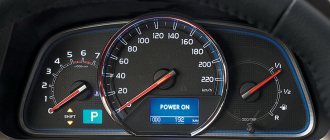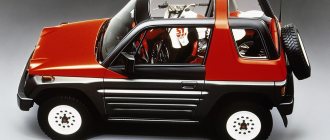Technical characteristics Reviews
The third generation Toyota RAV4 XA30 has become a very successful crossover. The car has gained a reputation as a woman's car, although this is not true, and thanks to the previous generation, the concept of “reliability” has been strengthened. Now there are a huge number of cars on the market for little money, the reliability of which we will understand.
The model appeared in 2006 and was on the assembly line until 2014. In 2010, the crossover was restyled, having changed greatly in appearance, receiving technical updates and a new body. Then in 2014, the fourth generation of Ravika appeared.
Design and body
It’s clear why a pre-restyling car is considered female – small, cute. At the front, the shape of the headlights has changed, between which there is a simple radiator grille with chrome elements. The inflated bumper is distinguished by a division in the middle and deepened PTF on the side. The profile has nothing to surprise other than the wide wheel arches, and the rear spoiler with an additional brake light looks beautiful.
The off-road appearance of the RAV4 XA30 is supported by a branded spare wheel on the trunk lid under plastic protection. The weight of the wheel gradually lowers the door, straining the hinges. Also, spare tires are stolen, so screw the pad onto the lock, or better yet, put the spare tire in the trunk.
The 3-door body is rare and practically never found in Russia. There is also a Long version extended by 225 mm.
In the 2010 restyling, the head optics became more aggressive due to elongation and narrowness. Between the headlights there is another radiator grille completely in chrome. We changed the shape of the bumper by making a protrusion at the bottom. The round fog lights were fitted with chrome trim. At the rear, the shape of the lights and bumper was changed. Occasionally there is a version without a remote spare wheel.
The paintwork is weak, which is why scratches and chips quickly appear. In winter, reagents contribute to the appearance of rust on the hood near the chrome. The owners forced the dealer to repaint the hood under warranty, as you can verify with a thickness gauge. Sometimes the factory wheels rusted, some were also able to replace them under warranty.
Dimensions of pre-styling Toyota RAV4 3:
- length – 4395 mm;
- width – 1815 mm;
- height – 1685 mm;
- wheelbase – 2650 mm;
- ground clearance - 191 mm.
After restyling, the length of the crossover increased to 4445 mm.
Exterior
The exterior design of the 3rd generation Rav 4 cannot be called a strong point of the SUV, but the Toyota crossover cannot be called a “freak” either. Rounded shapes, smooth transitions, and the absence of sharp transitions are characteristic features of the exterior not only of the Rav 4 2005, but also of other Toyota cars of those years.
The front optics are of a simple shape; between the headlights there is a large false radiator grille, consisting of two horizontal lines in the foreground and a plastic mesh in the second.
How do you like the appearance of the Rav 4 XA30?
The front bumper is massive with round fog lights located at the very edges. The radiator grille is divided into two parts by a wide bumper strip, on which the number is attached.
Looking at the car from behind, the first thing you see is the spare wheel cover. This is not to say that it spoils the appearance, but by modern standards it looks inappropriate. Small rear lights are located on pillars; they are not stretched out like competitors (X-Trail, CR-V). The fog lights are located on the massive rear bumper.
Rav 4 XA30 rear view
The photo shows that the Rav 4 XA30 2006 does not look like a trendsetter in automotive design.
Salon
This is an inexpensive car, so the manufacturer used simple materials inside in the form of fabric and plastic. Occasionally, the seats and steering wheel are covered with leatherette. All owners complain about the plastic - constant squeaks; you can solve the problem yourself, but you don’t want to. Similar disadvantages include sound insulation.
The car is small, but has enough free space. In front there are simple mechanically adjustable seats with a heating function. In the back there is a sofa with a folding armrest. If the seats are covered with leather, then most likely it has already cracked and is still creaking in the area where the plastic lining contacts the Toyota RAV4 XA30 trim. Sometimes water accumulates in the feet of the front passengers due to a “tired” seal under the frill or a burst antifreeze supply hose.
3-spoke steering wheel with multimedia control buttons. In restyling, the steering wheel is beveled from below. Behind the steering wheel, an analogue instrument panel is mounted in a common recessed well. The instrument panel consists of analogue tachometer, speedometer, fuel level and engine temperature sensors. In the middle is a classic on-board computer.
The two-section dashboard panel looks most beautiful in the middle. After the large 7-inch multimedia display with navigation, everything moves to the second section, equipped with a push-button climate control unit with a display monitor. Multimedia works together with an audio system consisting of 6 speakers. Closer to the tunnel there are a cigarette lighter, seat heating buttons and a niche for small items. The tunnel is equipped with two deep cup holders and a gear lever with a mechanical handbrake on the left.
Check the RAV4 air conditioner thoroughly; it may have excessive noise, damper gears may creak, or the damper basket of the compressor clutch may be damaged. These are minor problems, but I don’t want to face them.
The trunk in pre-restyling is larger - 586 liters, and with the rear sofa folded down it turns out to be 1469 liters. The restyled trunk is only 410 liters. The loading length was short, but the height was decent.
Off-road
Off-road operation, according to company representatives, is only possible where the terrain is light. But to understand the real state of affairs, it is necessary to turn to the reviews of the owners.
Many people complain about the cross-country ability of automatic versions, since such cars disable the rear wheels when the clutch overheats. This is how the vehicle’s electronics “protect” the gearbox.
But some owners still believe that eliminating slipping between the two axles will avoid this problem. It is enough to deflate the wheels to a pressure of 1 atm. If you drive correctly, you can drive on sand for hours.
There is another option when you are too lazy to flatten the wheels - drive at a stretch and try not to slip. This requires off-road driving experience, so the first option is preferable.
Car enthusiasts also share the secrets of off-road driving: there is no need to turn the steering wheel again, as this loads the blocked clutch, and the fluid inside it begins to heat up. Sharp turns should also be avoided.
Other owners of the third-generation Ravchik overcome the sand this way: block the rear axle, turn on ESP and shift the selector to first gear. But this is only relevant on special tires and where the wheel is completely hidden. For a normal trip, just turn on the “Drive” mode.
Some car enthusiasts claim that stopping in deep sand and then getting out of it without digging in will not be possible in a RAV4.
Engines
| Type | Volume | Power | Torque | Overclocking | Maximum speed | Number of cylinders |
| Petrol | 2.0 l | 152 hp | 194 H*m | 10.6 sec. | 185 km/h | 4 |
| Petrol | 2.4 l | 170 hp | 224 H*m | 10.6 sec. | 180 km/h | 4 |
| Petrol | 2.0 l | 158 hp | 224 H*m | 10.5 sec. | 185 km/h | 4 |
| Petrol | 3.5 l | 269 hp | 246 H*m | — | — | V6 |
| Diesel | 2.2 l | 134 hp | 310 H*m | 10.5 sec. | 180 km/h | 4 |
| Diesel | 2.2 l | 175 hp | 400 H*m | 9.3 sec. | 200 km/h | 4 |
Read more
The line of engines consists of basically familiar units, and the new engines have a similar design. List of internal combustion engines:
- 1AZ-FE – 2-liter engine with 152 horsepower and 194 H*m of torque;
- 2AZ-FE - 2.4-liter 170-horsepower engine with 224 units of torque;
- 2GR-FE – 3.5-liter V6 producing 269 horsepower and 246 H*m of torque. The motor was supplied to the American market;
- 3ZR-FE - a 2-liter engine of a restyled model with 158 horses with 198 units of torque and a Valvematic system that makes a roar;
- 2AD-FHV – 2.2-liter diesel engine producing 134 horsepower with 310 H*m of torque;
- 2AD-FTV – 2.2-liter diesel engine of Toyota RAV4 XA30, 175 hp. and 400 units of torque.
These are relatively reliable motors that can last 300 thousand, after which they need to be replaced. Of course, all this mileage will have to be done something, reliable does not mean not broken at all. All internal combustion engines are equipped with a timing chain drive, which must be changed after 200 thousand kilometers.
The 2.4-liter engine causes more problems; closer to 100 thousand kilometers it begins to consume oil, and before that the pump will fail, replacing which will cost 6,000 rubles. By 80 thousand kilometers, the guide rollers of the attachment belt will begin to make noise. It may also begin to lose power due to clogged injectors.
The Toyota RAV4 XA30 diesel is even more reliable, but the problems are more global. After 150 thousand kilometers, cracks appear around the liners, which leads to burnout of the cylinder head gasket. Due to the quality of our diesel fuel, fuel injectors are handed in at 200 thousand.
Many more complain about the gas pedal sticking on all engines. The problem on CTS pedals is solved by installing a metal plate. If the pedal is installed from DENSO, there will be no problems.
Transmission
The range of transmissions consists of a 5-speed manual and a 4-speed automatic. After restyling, they began to install a 5-speed automatic transmission, a 6-speed manual transmission, and a CVT variator appeared.
In a 5-speed manual, sometimes the first gear gets stuck and you have to press the clutch twice. The clutch disc itself runs for 200 thousand kilometers. Plus there is a howl from the first two gears. All this can be done inexpensively. There are a few more complaints about the machine. To extend life, change the oil every 60 thousand kilometers. The automatic transmission and CVT do not like slipping and towing trailers.
All-wheel drive RAV4 vehicles distribute torque through an electromagnetic clutch, which begins to hum at 150 thousand kilometers. The problem is the lack of oil, which escaped through leaking oil seals after 70,000 km. Oil seals and tails of gearboxes leak up to 100 thousand kilometers. Do not forget to change the oil in gearboxes every 40 thousand kilometers.
Suspension and brakes
The crossover sits on an all-round independent suspension. McPherson struts are used at the front, and two wishbones at the rear. Anti-roll bars have been added all around. The chassis is rigid and holds the car well in corners, although there is some roll.
First of all, the bushings and stabilizer struts in the suspension will have to be changed - at about 70,000 km. Rear stabilizers live for hundreds of thousands of kilometers. At around 100 km the front shock absorbers begin to fog, after another hundred the rear shock absorbers start to sweat, and the front shock absorbers will have to be replaced. Even in the suspension, every 150-200,000 km you will have to change the wheel bearings along with the bushing.
The steering of the RAV4 3 with electric power steering is weak. After fifty thousand kilometers, a knocking sound from the rack will appear, for several reasons: steering cardan, rack, steering shaft. Steering rods are capable of traveling 100,000 km. All around, disc brakes are equipped with a variety of electronic assistants:
- ABS;
- EBD;
- BAS;
- VSC;
- DAC;
- HAC.
The brakes are reliable, at most the ABS sensor fails.
Toyota RAV4 2020 safety systems
The fifth generation Toyota RAV 4 successfully passed Euro NCAP crash tests and received the highest 5 stars.
According to the tested criteria, I received the following ratings:
- protection of the driver and adult passenger – 93%;
- child passenger – 87%;
- vulnerable road users (pedestrians) – 85%;
- security devices (electronic assistants, etc.) – 77%.
The following active safety systems are installed:
- anti-lock braking system (ABS);
- electronic brake force distribution system;
- Brake Assist (BAS);
- traction control (TRC);
- Stability control system VSC+: (VSC-EPS);
- Hill Assist Control (HAC);
- Downhill Assist Control (DAC);
- Trailer Stability Control (TSC);
- integrated active management system AIM;
- selector for selecting the operating mode of off-road assistance systems (Multi Terrain Select).
Toyota Safety Sense 2.0 systems are offered only for the most expensive version of Prestige Safety:
- cruise control with the function of maintaining a safe distance to the vehicle in front (DRCC);
- dynamic cruise control with the function of simplified switching of the speed limit in accordance with restrictions on road signs (iDRCC);
- Lane Crossing Alert with Lane Keeping Assist (LTA);
- driver fatigue monitoring and information system (SWS);
- Forward Collision Warning with Automatic Braking and Pedestrian and Cyclist Sensing (PCS);
- road sign recognition and information system (RSA);
- Automatic high beam to low beam (AHB) system.
Passive safety systems:
- frontal airbags;
- side airbags for the first row of seats;
- curtain airbags for all rows of seats;
- Driver knee airbag;
- ISOFIX mountings for child car seats;
- motorist set.
Price
There are a huge number of offers on the secondary market, don’t cling to one copy, you can easily find more. Most of all on the market there are restyled models with an average price of 900,000 rubles , and sellers sell pre-restyled ones for 700,000 rubles .
This is a good reliable car, if you don't pay attention to the steering. Better take a closer look at the restyling, it’s still better. It’s difficult to call it the best in the segment; competitors of the Toyota RAV4 CA30 are cheaper to maintain and some are even better in terms of noise insulation and creaks in the cabin. Take it if you like it more than others.
Disadvantages of Toyota Rav 4 in the III generation
Toyota RAV4 in the 3rd generation has the following disadvantages:
- Poor sound insulation. Car enthusiasts have to modify the vehicle themselves to get the desired comfort in the cabin.
- No fifth gear. This is the main problem for those drivers who prefer to drive fast on the highway. The engine starts to run too loudly and fuel consumption increases.
- High cost of spare parts. Some car enthusiasts complain that replacing consumables is too expensive. If repairs are needed, they have to be postponed.
- Stiff suspension. Even small crushed stone can be felt on this car; some owners say that the third-generation Ravchik “constantly shakes.”
Many car enthusiasts note another disadvantage of the car - it “breaks through” the rear pillars.


